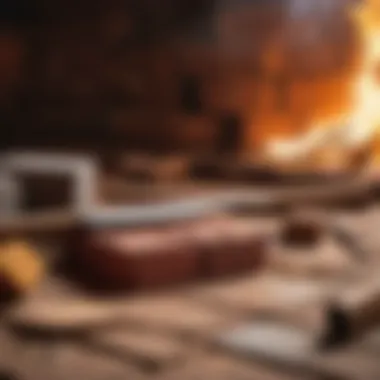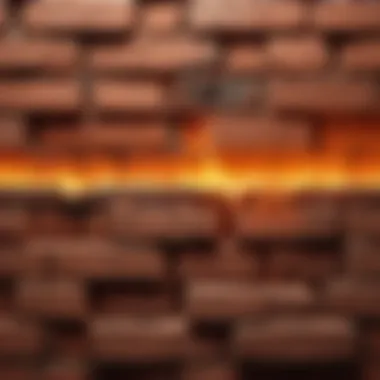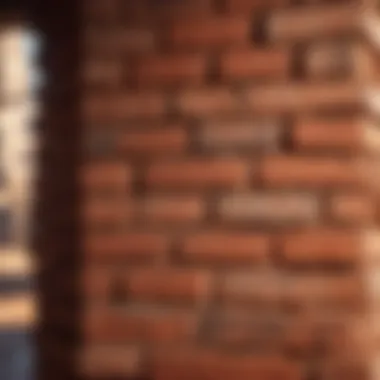Materials:
- Fire brick repair kit (including bricks, mortar, and tools)
- Safety gloves
- Safety goggles
- Dust mask
- Measuring tape
- Chisel
- Hammer
- Wire brush
- Water
DIY Steps:
-
Identify Crack Types: Inspect the fire brick structure for surface cracks, hairline cracks, or deep fissures.
-
Prepare Area: Clear the work area of any debris, dust, or loose particles using a wire brush.
-
Mix Mortar: Follow the instructions on the fire brick repair kit to prepare the mortar mixture to the required consistency.
-
Apply Mortar: Using a trowel, fill the cracks with the mortar mixture, ensuring smooth and even coverage.
-
Set Bricks: If necessary, replace damaged bricks by carefully removing the old ones and placing the new bricks securely in position.
Technical Aspects:
- Timing: Allow the mortar to set for the recommended time as per the kit instructions.
- Tools: Use the chisel and hammer for precise removal and replacement of bricks.
- Techniques: Maintain a steady hand while applying the mortar to achieve a seamless finish.
DIY Project Process:


-
Crack Identification: Carefully inspect all fire bricks for cracks and determine the appropriate repair method.
-
Preparation: Gather all materials and ensure the work area is clean and ready for repair.
-
Repair Application: Apply the mortar to the cracks or replace bricks as needed, following the provided instructions.
-
Setting Time: Allow the repaired area to cure for the recommended duration before using the fire brick structure.
Troubleshooting Tips:


- In case of excess mortar, use a damp cloth to wipe away the excess before it dries completely.
- If the mortar sets too quickly, adjust the consistency by adding water gradually.
- For uneven bricks, gently tap them into place with a hammer to ensure a flush alignment.
Understanding Fire Brick Cracks


Fire brick cracks are a critical aspect of maintaining fireplaces and stoves, as they can affect the integrity and performance of these structures. Understanding the different types and causes of fire brick cracks is essential for homeowners to effectively address any damage. In this article, we will delve into the various types of fire brick cracks, such as surface cracks, linear cracks, and corner cracks, and explore the root causes behind these issues.
Types of Fire Brick Cracks
Surface Cracks
Surface cracks refer to shallow cracks that are limited to the surface of the fire brick. While they may not penetrate deeply, they can still weaken the brick's structure and compromise its ability to withstand high temperatures. Surface cracks are commonly caused by rapid temperature changes and can lead to further cracking if left unattended. In this article, we will discuss the properties of surface cracks and the importance of addressing them promptly to prevent further damage.
Linear Cracks
Linear cracks are more significant than surface cracks, extending deeper into the brick. They can occur due to prolonged exposure to heat or mechanical stress. Linear cracks pose a greater risk to the structural integrity of the fire brick and may require specialized repair techniques. Understanding the characteristics of linear cracks is crucial for homeowners looking to maintain their fireplaces and prevent costly repairs.
Corner Cracks
Corner cracks occur at the corners of fire bricks and are often a result of thermal expansion and contraction. These cracks can gradually worsen if not properly treated, leading to more extensive damage over time. Addressing corner cracks promptly is vital to preserving the structural stability of the fire brick structure. In this article, we will explore the unique challenges posed by corner cracks and strategies for repairing them effectively.
Causes of Fire Brick Cracks
Heat Stress
Heat stress is a common cause of fire brick cracks, arising from prolonged exposure to high temperatures. The expansion and contraction of the brick material due to heat can lead to the development of cracks over time. Homeowners must be aware of the impacts of heat stress on fire bricks to implement preventive measures and minimize the risk of cracking.
Moisture Infiltration
Moisture infiltration can weaken fire bricks by compromising their structural integrity. Water penetration into the brick material can result in cracking, especially when exposed to rapid temperature changes. Understanding how moisture infiltration contributes to fire brick damage is essential for homeowners seeking to protect their fireplace or stove from extensive wear and tear.
Mechanical Damage
Mechanical damage, such as impacts or abrasions, can also contribute to fire brick cracks. Accidental knocks or abrasive cleaning methods can cause visible cracking in the bricks and compromise their functionality. Recognizing the signs of mechanical damage and its implications for fire brick durability is crucial for homeowners aiming to prolong the lifespan of their fireplaces.
Preparation for Repair
In the comprehensive guide to repairing fire brick cracks, the preparation phase holds paramount importance. Before undertaking any repair work, thorough preparation is essential to ensure the success and longevity of the restoration. Adequate preparation sets the foundation for the repair process, making it crucial to understanding the nuances of fire brick structures and cracks. By focusing on preparation, individuals can address the root causes of the cracks and implement effective solutions, thereby enhancing the structural integrity of the fire bricks.
Gathering Materials and Tools
Fire Clay
Fire clay plays a pivotal role in fire brick crack repair, known for its exceptional heat resistance properties and malleability. Within the context of this article, fire clay is a preferred choice due to its ability to withstand high temperatures and bond seamlessly with fire brick surfaces. The key characteristic of fire clay lies in its ability to withstand thermal stresses, making it an ideal material for repairing fire brick cracks. Additionally, the unique feature of fire clay is its high alumina content, contributing to its superior bonding strength and durability. While fire clay offers excellent adhesion properties, it is essential to note that it may require longer curing times compared to other repair materials, a factor to consider during the repair process.
Wire Brush
The wire brush is an indispensable tool for cleaning and preparing fire brick surfaces before repair. Its key characteristic lies in the stiff bristles designed to effectively remove debris, dust, and loose particles from the crack sites. The wire brush's primary advantage in this context is its ability to create a clean and roughened surface, promoting better adhesion between the repair materials and the fire bricks. A unique feature of the wire brush is its versatility in reaching tight spaces and corners, ensuring thorough cleaning of the cracks for optimal repair outcomes. However, one disadvantage of the wire brush is the potential to cause abrasions on the fire brick surface if excessive pressure is applied, emphasizing the need for controlled usage during preparation.
Fire Brick Saw
A fire brick saw is a specialized tool that facilitates precise cutting and shaping of fire bricks during repair work. Its key characteristic lies in the sharp blade designed to cut through dense fire brick material with accuracy and efficiency. The fire brick saw is a beneficial choice for this article due to its ability to create clean and precise grooves for accommodating repair materials. A unique feature of the fire brick saw is its adjustable blade depth, allowing users to customize cuts according to the crack's depth and width. While the fire brick saw streamlines the repair process, one consideration is the potential for generating dust and debris during operation, underscoring the importance of wearing protective gear and working in well-ventilated areas.
Cleaning the Cracks
Removing Debris
Removing debris from fire brick cracks is a critical step in the repair process, essential for ensuring proper adhesion of the repair materials. The specific aspect of removing debris involves clearing the crack site of loose particles, ashes, and old mortar residue. This step contributes significantly to the overall success of the repair by creating a clean and stable surface for the subsequent application of repair materials. The key characteristic of debris removal is its ability to uncover the true extent of the crack, allowing for thorough inspection and targeted repair. While removing debris is a beneficial choice for this article, one potential disadvantage is the labor-intensive nature of this task, particularly in cases where the cracks are deep or intricate.
Eliminating Dust
Eliminating dust plays a vital role in preparing fire brick cracks for repair, ensuring optimal bonding of the repair materials to the brick surface. The specific aspect of eliminating dust entails thorough cleaning using compressed air, brushes, or vacuum to remove fine particles from the crack crevices. This step is beneficial for this article since dust removal promotes a cleaner surface, preventing interference with the repair material adhesion. A key characteristic of dust elimination is its ability to improve the overall aesthetics of the repair, creating a seamless finish once the repair is complete. However, one consideration to bear in mind is the potential health hazard posed by airborne dust particles, highlighting the importance of wearing appropriate protective gear such as masks and goggles during cleaning.
Repair Techniques
Repair techniques play a crucial role in the comprehensive process of repairing fire brick cracks. These techniques are essential for ensuring the longevity and structural integrity of fire brick structures. By employing the right repair techniques, individuals can effectively address minor and major cracks, preserving the overall functionality and appearance of the fire brick installation.
Filling Minor Cracks
Filling minor cracks in fire brick structures is a critical step in preventing further damage and maintaining the performance of the heating system. One of the key methods for repairing minor cracks is using refractory mortar, a specialized compound designed to withstand high temperatures and adhere well to fire bricks.
Using Refractory Mortar
Utilizing refractory mortar is imperative when dealing with minor cracks, as it offers excellent heat resistance and bonding properties. Refractory mortar is specifically formulated to withstand extreme temperatures, making it an ideal choice for repairing fire brick cracks. Its ability to withstand thermal shock and rapid temperature changes ensures long-lasting repair results. While refractory mortar provides exceptional durability and thermal insulation, it is essential to ensure proper application and curing to maximize its effectiveness.
Mending Major Cracks
Addressing major cracks in fire brick structures requires more intensive repair techniques to restore structural stability. Cutting V-shaped grooves and applying patching compound are two effective methods for mending major cracks and preventing further deterioration.
Cutting V-shaped Grooves
Cutting V-shaped grooves is a strategic approach to repairing major cracks by creating a secure channel for the patching material to adhere to. This technique enhances the bond between the existing fire bricks and the patching compound, ensuring a seamless and durable repair. The key characteristic of cutting V-shaped grooves is its ability to increase the surface area for adhesion, promoting a stronger and more reliable bond. While this method requires precision and expertise, it significantly contributes to the long-term structural integrity of the fire brick installation.
Applying Patching Compound
Applying patching compound is essential for filling large gaps and cracks in fire bricks, providing a seamless finish and structural reinforcement. Patching compound offers flexibility and durability, adapting to the thermal expansion and contraction of the fire brick structure. The unique feature of patching compound lies in its ability to bond effectively with fire bricks, creating a cohesive repair that withstands high temperatures and environmental stressors. While patching compound offers enhanced strength and thermal resistance, proper application techniques and curing procedures are crucial for optimal results.
Finishing Touches
In the realm of repairing fire brick cracks, the section on Finishing Touches holds paramount importance. This particular phase encapsulates the culmination of the repair process, emphasizing the final steps crucial in ensuring the structural integrity and longevity of the repaired fire brick construction. The Finishing Touches segment serves as the concluding flourish that not only enhances the aesthetic appeal of the mended area but also adds a protective layer that promotes durability. By delving into the nuances of Finishing Touches, individuals can guarantee that their repaired fire brick structures are not only visually appealing but also functionally robust.
Curing the Repaired Area
Allowing Proper Drying Time:
The concept of Allowing Proper Drying Time is a cornerstone in the arena of fire brick repair. This essential aspect plays a pivotal role in the overall success of the repair process by ensuring that the applied materials and compounds have sufficient time to cure and settle effectively. Allowing Proper Drying Time is a critical phase as it allows for the consolidation and hardening of the repair materials, thereby fortifying the structural integrity of the fire brick. This strategic approach not only fosters adherence but also minimizes the risk of premature cracks or damage, offering a long-lasting solution to fire brick repair. The deliberate act of Allowing Proper Drying Time stands as a testament to meticulous craftsmanship and dedication to quality, showcasing a commitment to excellence in fire brick restoration.
Insulating the Area
Applying Insulation Material:
The aspect of Applying Insulation Material embodies a protective shield vital in maintaining the repaired fire brick structure. By applying insulation material, individuals create a barrier that safeguards the repaired area from external elements and temperature fluctuations. The key characteristic of Applying Insulation Material lies in its ability to regulate heat distribution, thereby preventing potential cracking or deterioration due to extreme temperatures. This strategic choice of insulation material not only enhances the thermal efficiency of the fire brick structure but also prolongs its lifespan by shielding it from environmental stressors. The unique feature of Applying Insulation Material is its versatility, offering a cost-effective and sustainable solution to enhance the resilience of fire brick repairs in various settings. By integrating insulation material into the repair process, individuals ensure that their fire brick structures are well-insulated and protected, adding an extra layer of defense against potential damage.
Maintenance Tips
Maintenance tips are crucial in ensuring the longevity and optimal functionality of fire brick structures. Regular upkeep not only enhances the lifespan of the bricks but also ensures safe usage. By incorporating effective maintenance practices, homeowners can detect potential issues early on, preventing costly repairs down the line. These tips offer a proactive approach to preserving the integrity of fire brick structures through consistent monitoring and care.
Regular Inspections
Proactive inspections play a vital role in identifying minor cracks or signs of wear and tear before they escalate into major issues. Monitoring crack development is a specific aspect of regular inspections that allows homeowners to track the progression of any existing cracks. By closely observing these cracks, individuals can take timely action to address them, thus maintaining the structural integrity of the fire brick. This method is highly beneficial in the context of this article as it empowers readers to adopt a preventive stance towards fire brick maintenance, promoting cost-effectiveness and structural stability.
Monitoring Crack Development
The key feature of monitoring crack development lies in its ability to provide early warnings of potential structural weaknesses. By regularly checking and measuring the size and depth of cracks, individuals can assess the severity of the damage and intervene accordingly. This method's advantage in this article lies in its proactive nature, allowing homeowners to address issues before they worsen and require extensive repairs. Although time-consuming, monitoring crack development ultimately saves money and ensures the structural soundness of fire brick constructions.
Avoiding Extreme Temperatures
Extreme temperatures can adversely affect the durability and performance of fire bricks. By moderating heating practices, homeowners can protect their fire brick structures from thermal shock and prevent cracks or damage from occurring. Consistent temperature control is vital in avoiding sudden temperature fluctuations that can compromise the integrity of the bricks, ensuring their long-term functionality.
Moderating Heating
Moderating heating involves controlling and gradual adjustment of temperatures to prevent sudden changes that may stress the fire bricks. This practice is paramount in maintaining the structural integrity of the bricks, minimizing the risk of cracks or breakage due to thermal expansion. The unique feature of moderating heating in this article lies in its ability to offer practical guidance to homeowners on ensuring stable and safe heating practices for their fire brick structures. While moderating heating requires diligence, the benefits of safeguarding fire bricks against extreme temperatures far outweigh the effort involved.





